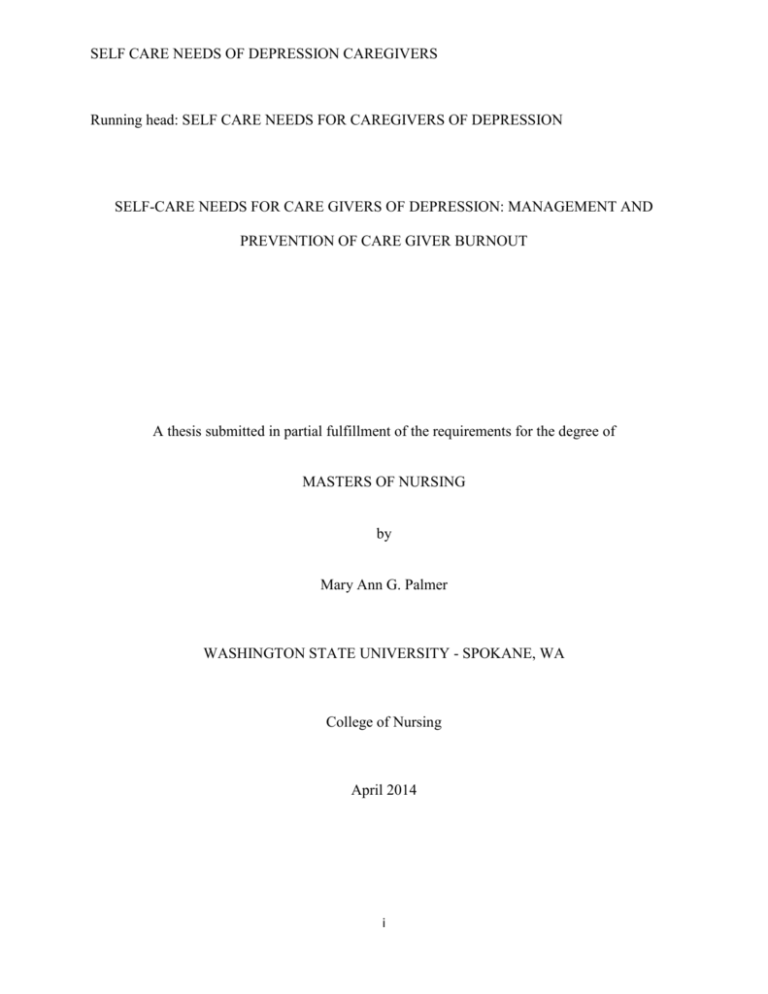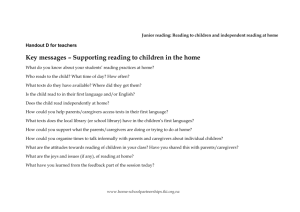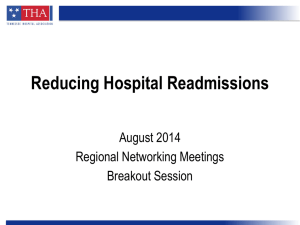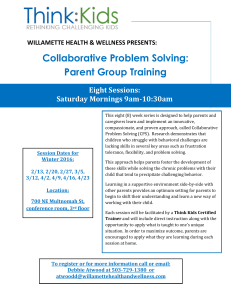M_Palmer_10970196 - Washington State University
advertisement

SELF CARE NEEDS OF DEPRESSION CAREGIVERS Running head: SELF CARE NEEDS FOR CAREGIVERS OF DEPRESSION SELF-CARE NEEDS FOR CARE GIVERS OF DEPRESSION: MANAGEMENT AND PREVENTION OF CARE GIVER BURNOUT A thesis submitted in partial fulfillment of the requirements for the degree of MASTERS OF NURSING by Mary Ann G. Palmer WASHINGTON STATE UNIVERSITY - SPOKANE, WA College of Nursing April 2014 i SELF CARE NEEDS OF DEPRESSION CAREGIVERS To the Faculty of Washington State University: The members of the Committee appointed to examine the master’s project of ____Mary Ann G. Palmer ____________find it satisfactory and recommend that it be accepted. __________________________________________ Mel Haberman, PhD, RN, FAAN, Chair __________________________________________ Anne Mason DNP, ARNP, PMHNP-BC __________________________________________ Sandy Carollo PhD, ARNP, FNP ii SELF CARE NEEDS OF DEPRESSION CAREGIVERS Self-Care Needs of Family Caregivers of Depression: Management and Prevention of Caregiver Burnout Abstract By Mary Ann G. Palmer, RN, BSN Washington State University April 2014 Chair: Mel Haberman Submitting to the Journal of the American Academy of Nurse Practitioners Depression is one of the common mental disorders, affecting 6.6% of adult Americans yearly, yet over 80% are not treated (Center of Disease Control & Prevention [CDC], 2010). Related to depression, about 30,000 Americans commit suicide each year, and about 500,000 make suicide attempts that warrant emergency care (CDC, 2010; Nicholas & Golden 2001). Depression varies in severity and demography, and presents a significant health concern not only in America but throughout the world. The onset is gradual, episodic in nature, and clinically manifest at adulthood. Depressed persons are usually cared for by family members at home (National Institute of Mental Health [NIMH], 2008). Therefore, supporting family caregivers is crucial for the survival and recovery of this group of patients. Family caregivers are at risk of developing behavioral and health problems due to the burden of caregiving (Highet et al., 2005). Understanding the circumstances that influence caregiver’s ability to care for depressed members will provide perspectives on treating depression, improve the caregivers' quality of life, prevent delay in treatment, and minimize the iii SELF CARE NEEDS OF DEPRESSION CAREGIVERS frequent relapses among depressed persons (Wijngaarden et al., 2009). This paper reviews the current literature on physical, psychological, and social stressors that challenge the caregiver's ability to provide care to a family member with depression and presents the current evidence on prevention and management of caregiver burnout. Key Words: caregiver, family care giver, informal caregivers, carer, stress, burnout, burden, anxiety, depression treatment, bipolar, depression, mental health disorders, caregiver burden, caregiver burnout, chronic illness and depression, caregivers and depressive symptoms, care giving risk factors, care giving burden, and evidence based practice on stress reduction iv SELF CARE NEEDS OF DEPRESSION CAREGIVERS TABLE OF CONTENTS Page ABSTRACT............................................................................................................................... iii STATEMENT OF PROBLEM....................................................................................................1 LITERATURE RESEARCH STRATEGIES.............................................................................. 3 THEORETICAL FRAMEWORK............................................................................................... 4 LITERATURE REVIEW............................................................................................................ 4 STRESSOR OF CAREGIVER BURNOUT…………………………………………... 4 CAREGIVERS’ PHYSIOLOGICAL RESPONSES....................................................... 6 CAREGIVERS’ PSYCHOLOGICAL RESPONSES..................................................... 7 CAREGIVERS’ SOCIAL RESPONSES TO LIFE........................................................ 8 MANAGEMENT AND PREVENTION……………………………………………… 9 SIGNIFICANCE TO ADVANCED NURSING PRACTICE.....................................................11 RECOMMENDATION FOR RESEARCH................................................................................ 12 REFERENCES............................................................................................................................ 14 v SELF CARE NEEDS OF DEPRESSION CAREGIVERS Self-Care Needs for Care Givers of Depression: Management and Prevention of Care Giver Burnout Depression is a disorder characterized by severe negative changes in mood, thinking, and behavior that affect a person's daily life, functioning, and causes distress for both the person with depression and his or her caregiver (McCance & Huether, 2006; McDowell, 2006). According to Center of Disease Control & Prevention (CDC) (2010), depression is the leading cause of disability for Americans between age of 15 and 44. About 17 million adults Americans suffer from depression yearly and the clinical manifestation is episodic, unpredictable, and disabling in nature (National Institute of Mental Health [NIMH], 2010). Depression occurs in various forms and is more common in women than men, co-exists with many medical conditions, and contributes to about 30,000 yearly suicides in America (NIMH, 2010). Onset of depressive symptoms usually starts at adulthood and depressed persons are usually cared for at their home by their spouses or family members (NIMH, 2010). A family caregiver is defined as a friend or relative who provides unpaid assistance to a person with chronic or disabling conditions (Family Caregiver Alliance 2006; Highet, Thompson, & McNair, 2005). For some caregivers, caring for a person with depression is an obligation or fulfillment of personal commitment, but the associated burden of physical and psychosocial instability is a threat to caregivers’ well-being (Naiditch et al., 2006). Caregivers of depressed persons are faced with unavoidable stress and burden and often report symptoms similar to the depressed person being cared for (Benazon & Coyne, 2000). 1 SELF CARE NEEDS OF DEPRESSION CAREGIVERS Caregiver burden is defined as the "physical, emotional, and social impact of the stress of caregiving" (Philips et al., 2009, p. 336). The high caregiving demand negatively influences healthy practices, restriction in social activities, decreases family income, and strains relationships (Philips et al., 2009; Robinson et al., 2009). The negative influences on the caregiver’s health stems from abandonment of self-care habits and preventive care practices due to the burden of caregiving. This places caregivers at risk for developing heart diseases and other health problems (Kanel et. al., 2006). In America, more than 34 million unpaid caregivers provide care for persons with disabilities at home, 83% are family caregivers, and about 21% of American households are negatively impacted by the caregiving role (CDC, 2011). The caregivers’ health risk survey by Naiditch et al. (2006) found 53% reported of declining health as the outcome of caregiving role, 90% reported increasing stress, and 69% reported restriction of social activities. Other findings indicated 10% misused alcohol or prescription drugs, 82% reported sleeping was worse, 63% reported their eating habits were worse, and 58% reported their exercising had been reduced to include 51% reported taking more medications as the results of providing the caregiving tasks. Kanel et al. (2006) indicated the high risk of developing cardiovascular disorders in older caregivers as one of the physiologic consequences of sleep deprivation related to chronic exposure to stress. The research literature is replete with findings of higher prevalence and incidence of psychiatric symptoms in caregivers. Steele, Maruyama, & Galynker, (2010) analysis of caregivers of depressed bipolar persons found 46% reported depression and anxiety and up to 32.4% reported the use of mental health services. Dealing with the negative symptoms of depression and seeing their loved ones suffer from depression are disturbing facets of caregiving 2 SELF CARE NEEDS OF DEPRESSION CAREGIVERS that contribute to greater burden and disruption in family functioning (Naiditch et al., 2006). The caregiver’s stressful role causes feelings of anger, sadness, exhaustion, and guilt including stress, depression, and anxiety (Highet, Thompson, & McNair, 2005). Often caregivers sacrifice their own physical and emotional needs in an effort to provide the best possible care for their depressed loved ones. Even the most capable caregivers can be negatively impacted by the physical and emotional strain involved in caring for depressed persons at home (Naiditch et al., 2006). To maintain the well-being of caregiver and the depressed person, the caregiving role must be recognized and supported by health care providers due to the significant strain associated with the role. For example, the family caregiver’s level of expressed emotion has been positively associated with the prolonged recovery including frequency of relapses, exacerbation of depression, and duration of depressive symptoms (Milklowitz, 2007). On the other hand, respite care services or support groups eased the burden of caregiving (Hartman et al., 2012). The purpose of this paper is to examine the evidence pertaining to the stressors that negatively impact the caregiver's physiologic, psychological, and social aspects of life and to summarize evidence-based practices for the prevention and management of caregiver burnout. The population of interest is male and female caregivers 18 years of age and older who care for persons with depression or depression with co-morbid chronic conditions. Literature Search Strategies Initially, a general internet search was conducted using the Google search engine using the words and phrases: care giver, family care giver, carer, stress, burden, depression, bipolar, mental health disorders, care giving risk factors, care give burden, and evidenced-based practice on stress reduction. The research was narrowed using the multiple database searches: CINAHL,; 3 SELF CARE NEEDS OF DEPRESSION CAREGIVERS PubMed,; and PsychINFO,; Cochrane,; and ProQuest. Seventy articles were identified as the most relevant to the topic of the paper. These were narrowed to 21 scholarly articles and four books. These materials were organized into the following categories: (a) stressors of caregiver burnout (3 articles), (b) caregivers’ physiologic responses (4 articles), (c) caregivers’ psychological responses (5 articles), (d) caregivers’ social responses to life (5 articles), and (c) management and prevention of caregiver burnout (4 articles). These categories provide the organizational framework for the literature review Theoretical Framework Neuman's System Model is the theoretical framework that guides this paper. Betty Neumann developed the theory in 1972 based on human reactions to stress. The model describes the importance of balancing the human dynamic through the use of the nursing process for collection of data and formulation of goals (McEwen & Wills, 2011). The core concept of the model is the assumption of "prevention as intervention." Neuman’s model suggests that the causes of stress can be remedied through prevention, thus maintaining the optimal functioning of human beings (McEwen & Wills, 2011). In this paper, the goal is to discover the activities and interventions that best support the well-being of caregivers who care for depressed persons so that caregivers can continue to perform the role. Primary prevention includes the understanding of depression along with its treatment and management, early recognition of signs and symptoms of burnout, and promotion of self-seeking behavior to include counseling and effective coping skills for stress reduction. Secondary prevention focuses on the reduction of care giving tasks through the use of community resources such as support groups, respite care, home care services, skilled nursing services, or adult day centers for relief of direct care giving tasks. Promoting caregivers’ well4 SELF CARE NEEDS OF DEPRESSION CAREGIVERS being improves the quality of life for both caregivers and the depressed persons and prevents caregiver burnout. Literature Review Stressors of Caregiver Burnout The major stressors that cause caregiving burden for depressed person are the negative symptoms of depression such as, feeling of sadness, anxiety, agitation, guilt, irritability, loss of interest or pleasure in normal activities, sleep disturbances, lack of energy, feeling worthlessness, changes in appetite or weight, difficulty thinking or concentrating, frequent thoughts of death, suicide attempts, and unexplained physical problems (Diagnostic and Statistical Manual of Mental Disorders, Fifth Edition [DSM-5], 2013). These episodic symptoms occur every day for at least 2 weeks or longer and create significant distress or impairment in social, occupational, and other important areas of a person’s daily functionality (DSM-5, 2013; Perlick et al., 2007). Benazon and Coyne (2000) found the depressed persons negative behaviors were significantly correlated to caregiver burden and marital functioning (r = .49, p = < .05). The subjective burdens were the depressed person’s feeling worthlessness, endless constant worrying, and lack of energy to include the possibility of re-occurrence and spouse’s emotional strain. The finding indicated that living with a depressed person is associated with caregiver burdens and this should be taken seriously when treating the depression. In addition, Wijngaarden et al. (2009) discussed that the lack of energy, lack emotion, withdrawn mood, and sexual impairment places strain on marital relationship, which leads to higher level of caregiving consequences and poor family function. 5 SELF CARE NEEDS OF DEPRESSION CAREGIVERS Furthermore, Perlick et al. (2007) qualitative study of 500 caregivers of depressed bipolar persons found 89% of caregiving burden was related to negative behaviors, 52% role dysfunction, and 61% disruption of household routine. This higher level of burden resulted in more medical conditions (M = 1.06, SD = 1.25, p = .014), depressive symptoms (M = 37.44, SD = 2, p = .001), health risk behavior (M =1.65, SD = 0.47, p = .001) or usage of health care services (M = 1.63, SD =1.48, p = .013), and less social support (M =14.12, SD = 2.20, p = 0.65) including higher financial cost (M = 1,026.0, SD = 1570.5, p = .002). Therefore, clinical interventions that focused on caregivers' burden would improve the health of caregivers and depressed persons (Shimazu et al., 2011). Caregivers’ Physical Responses Chronic exposure to stress causes fatigue and deterioration of caregivers' well-being, neglect of self-care habits, and preventive health care practices (Naiditch et al., 2006). Caregivers were overwhelmed and felt like they were losing their lives due to the difficulties of balancing the relationships, adapting to the role, and advocating care with health care professionals (Stjernsward & Ostman, 2008). The caregiving role created stress, restriction of social activities, and the isolation from family members and friends intensified the emotional stress leading to neglect of self-care habits such as, healthy sleep, exercise, and diet placing them at risk of developing serious illnesses (Kanel et al., 2006). The health consequences were also reported in qualitative and quantitative study by Naiditch et al. (2006) in a sample of 528 caregivers whose health declined as a result of providing care to depressed persons with multiple chronic diseases. Fatigue, stress, pain, and depression were the most common reported symptoms. About 87% of caregivers reported worsening health problems such as high blood 6 SELF CARE NEEDS OF DEPRESSION CAREGIVERS pressure, headaches, unstable weight, shortness of breath, digestive problems, and loss of appetite. Kanel et al. (2006) focused on the link between lack of sleep and the development of heart disease or stroke in 113 caregivers caring for depressed persons with Alzheimer’s disease. The investigators’ found that insomnia was statistically significantly associated with higher serum level of plasma IL-6 (p =.01) and D-dimer (p = .01). These immune variables were associated with the development of cardiovascular disorders in older caregivers and were the physiologic results of stress. Furthermore, in the random interview by Haley et al. (2009) in 716 caregivers of depressed disabled persons, African-American male caregivers scored 23% higher than the predicted stroke risk score model utilizing the Framingham Stroke Risk tool (F [2,677] = 3.17, p=0.04). The above evidence indicates that the caregiving role for depressed persons is stressful and burdensome; therefore, more should be done to support the caregivers as they cope with stressors so that becoming sick can be prevented. Caregivers’ Psychological Responses The literature reviewed by Steele, Maruyama, & Galynker, (2010) found that 46 % of caregivers experienced depression and anxiety as the outcome of their strained role and up to 32.4% utilized mental health services. Clearly, the caregivers need interventions that target psychiatric symptoms. Also, Perlick et al. (2005) qualitative study in 264 caregivers showed that caregiver burden continued to be the significant predictor of mental health service use (OR = 13.53, p = < 0.001) even after controlling the socio-demographic, medical conditions, and symptoms of anxiety and depression in caregivers. Up to 72% of caregivers used primary care service (OR = 1.72, p = 0.02). The significant predictor was caregivers’ untreated symptoms of 7 SELF CARE NEEDS OF DEPRESSION CAREGIVERS anxiety and depression as the outcome of caregiving to depressed bipolar patients. In addition, Philips et al. (2009) cross-sectional and prospective observational study in 393 caregivers using the Hospital Anxiety Scale (HADS) found significant link between caregiving strain (M = 3.34, SD = 2.4, p = 001) and caregiving burden (M = 3.12, SD = 25.6, p = .002), which were also positively associated to depression (M = 4.0, SD = 2.90, p = .01). The authors further explained that caregivers experienced higher caregiving strain and burden and reported worsening of symptoms of depression even after adjustment of socio-demographic risk factors. Smith et al. (2011) longitudinal study in 310 informal caregivers of depressed elderly with multiple chronic illnesses indicated that increase in caregivers’ stressors (M = 77. 9, SD = 8.7, p = <. 01) were related to caregiver depressive symptoms (M = 14.4, SD = 11.5, p = < .01). Therefore, increased caregivers depression and decrease in respectful behavior predicted a potential harmful behavior (p = < .001) in caregivers. This significant finding indicates that changes in caregivers’ stressors, depressive symptoms, and disrespectful behavior may indicate that interventions are needed in order to prevent poor quality of care. On the other hand, Highet, Thompson, and McNair (2005) qualitative study discovered that failure to associate the distinct psychological, behavioral, and physiological symptoms of depression resulted in the caregivers' feeling of helplessness, confusion, and guilt. The limitation of this qualitative study was the small population (N = 37). The finding suggested interventions that focus on education to enhance the recognition and awareness of depression and its treatments, reduces the caregivers' psychological strain, and improves caregivers' quality of life as well as the depressed persons. Caregivers’ Social Responses to Life 8 SELF CARE NEEDS OF DEPRESSION CAREGIVERS Wijngaarden et al. (2009) qualitative study conducted in 252 caregivers found that caregivers caring for depressed persons were themselves at risk for psychosocial burden. The contributing factors for the caregivers’ burden were 48.6% worried about depressed persons’ general health, 27.4 % reported interpersonal strain, and 25.4 % were concerned about safety. The authors further discussed that the depressive symptoms in combination with medication side effects could lead to gradual loss of intimacy and marital discord, which had a negative impact on recovery. Robison et al. (2009) study of 4,041 caregivers caring for depressed elderly persons with chronic disorders found that caregiving burden negatively affected the caregivers’ health (OR =1.34, p = .03), work (OR = 1.48, p = 0.13), and social status (OR =1.22, p = .29). Caregivers who were not supported by health care professionals missed work, felt depressed, and socially isolated, which lead to caregiver burnout and institutionalization of the depressed elderly persons. Also, Philips et al. (2009) study of 393 caregivers found the strong association of social isolation (M = 4.2, SD = 4.52, p = .05) and poor sleep (M = 5.2, SD = 3.01, p = .001) to caregivers’ depression and anxiety score (p = < .05) as an outcome of caregiving burden. It was discussed in the study that the long-term exposure to caregiver strain and burden could worsen the symptoms of depression and anxiety of caregivers. Perlick et al. (2007) cross-sectional study investigated the association of perceived stigma, depressive symptoms, and avoidance coping among 500 caregivers of depressed bipolar persons. Perceived stigma was positively associated with less social support (r = 0.24, p = < .001) and avoidance coping (r = 0.18, p = < .001), which was accountable for 63% of the relationship between caregiver stigma and depression. The authors explained that perceived stigma may negatively affect the caregiver mental health by reducing their coping effectiveness. 9 SELF CARE NEEDS OF DEPRESSION CAREGIVERS Also, Rowe (2012) literature review found poor communication and engagement between caregivers and health professionals added to the caregiver burden. Caregivers felt an obligation to care, advocate or share information, and assist in the patient’s recovery, but the constraints on public policy in confidentiality and informed consent issues were barriers to good relationship. According to the author, the key for effective care was to acknowledge their obligations, respect them as partners, and develop a trusting relationship. This would facilitate effective care at home and improve quality of life for patients and prevent caregiver burnout (Rowe, 2012). Management and Prevention of Caregiver Burnout To become sick is one of the greatest risks for most caregivers due to the consequences of caregiving burden, which makes them less likely to engage in preventive care health measures and places them at risk of developing serious illness. Nurse Practitioners can perform a caregiver assessment to identify needs, strengths, and resources for the family caregiver. Changes in functional status of caregiver and patient, transitions care, and medical diagnosis such as, dementia, heart failure, stroke, or cancer should trigger an assessment for caregiver burnout (Family Caregiver Alliance, 2006). The assessment findings can be used to develop a care plan and to identify appropriate support services. Early education on signs and symptoms of depression can reduce confusion, feeling of helplessness, and guilt among family members (Highet, Thompson, & McNair, 2005). According to the study of Shimazu et al. (2011), the psycho-educational intervention for specific behavioral issues had the most consistent effects on prevention of depression relapse of the depressed person. The relapse rate for 9 months follow up was reduced to 8% in the intervention group who underwent the four psycho-educational sessions consisting of didactic lectures about depression and problem solving targeting on how to cope with the negative 10 SELF CARE NEEDS OF DEPRESSION CAREGIVERS behaviors of depressed persons. The relapse was significantly longer in intervention group (M = 9.57, SD = 1.0, p = .002). In addition, Perlick et al. (2010) experimental study found the Family Focused Treatment – Health Promoting Intervention (FFT – HPI) was effective in reducing the caregiver’s level of depression (M = 4.6, SD = 2.9, p = 0.037) and avoidance coping (M = 2.0, SD = 2.3, p = 0.029) over the course of therapy. Therefore, the decrease level in depressed person’s symptoms is mediated by reduced in caregiver’s level of depression and avoidance coping. In a situation wherein marital distress is perceived as the major problem, Barbato and Avanso (2009) meta-analysis on marital discord and depression found that marital therapy was a superior intervention for discord relationship (SMD = -1.28 (95% Dl – 1.85 - .72). Marital therapy improved the interactions among couples and enhanced mutually supportive relationship. Another example is the literature review of Denton et al. (2003) on couple distress and depression suggested that couple therapy was an effective intervention to reduce tension, provide coping skills, and improve caregivers' abilities to cope with the patient’s negative behavior. Finally, to help ease the feeling of depression and promote caregivers' well-being, support groups should provide contact and emotional support. The respite and psychosocial support services provided the best evidence to reduce caregiver burden (Harman et al., 2012). Primary prevention consists of increasing awareness of depression, knowing signs of burnout, promotion of healthy life styles, and ways to deal with stress. The education can be done during patient and family caregiver encounters. Secondary prevention includes the use of community resources such as respite care services, home maker and home health aide, adult day care, or nursing skilled care services to provide temporary breaks to caregivers from the demand of daily care giving tasks. In addition, the referral and use of mental health services such as therapies, 11 SELF CARE NEEDS OF DEPRESSION CAREGIVERS counseling, and support groups are effective interventions for reduction of stress and prevention of depression and anxiety. Significance to Advanced Practice Nursing Caring for a relative with depression is a distinct and unique experience that not all are prepared for. It consists of caregiving obligations and consequences (Naiditch et al., 2006). Health care providers including Nurse Practitioners (NP's) believe in maintaining the optimal level of functioning through prevention as intervention with the optimal goal of focusing on the degree of primary and secondary prevention. Primary prevention includes education on the epidemiology of depression and its treatments, early detection of burnout, and encouragement of self-care along with healthy coping mechanisms to combat stress and potential health problems. NP's can also utilize practice guidelines or assessment tools for identifying the early signs and symptoms of stress, depression, or burnout among caregivers, which could make them feel valued as a partner at home (Family Caregiver Alliance, 2006). The assessment outcome will be used for care planning involving family care givers in prevention and treatment approaches. Collaborating and coordinating care with mental health professionals and counselors are crucial tools in maintain continuity of care. Other identified unmet care giving needs can be directed to appropriate health care professionals for assistance through community resources. NP's can promote self-care strategies such as taking breaks, maintaining healthy lifestyle, seeking preventive care, joining a support group or counseling, and finding respite care for direct care giving assistance. NP's can also introduce coping strategies such as praying, talking with friends and family, and relaxation techniques for stress management (Shimazu et al., 2011). Other resources include lists of on-line care giving resources, toolkits, or planning guides given during an office visit (Family Care giving Alliance, 2006). 12 SELF CARE NEEDS OF DEPRESSION CAREGIVERS Recommendation for Nursing Research The studies on the caregiving consequences for caring the depressed person without comorbid chronic conditions are limited. Further research needs to be done on this group of caregivers to better serve the depressed persons at home and to prevent caregiver burnout. Caregiver assessment can be embedded as part of the guidelines for chronic delivery, in which collection of data can be performed by NPs or other health care team members. Further research needs to explore the frequency of assessment and which caregivers should be assessed for caregiver burnout for those who have multiple family members involved in their care. Maintaining patient confidentially is crucial in providing care to patients and their families. Further research needs to be done on the effectiveness of including informed consent during admission and discharge in order to maintain continuity of care and prevent frustration for caregivers. 13 SELF CARE NEEDS OF DEPRESSION CAREGIVERS References Barbato, A. and Avanso, B. (2009). Marital therapy for depression. Cochrane Database of Systematic Reviews, 2. doi: 10.1002/14651858.CD004188.pub2 Benazon, N. & Coyne, J. (2000). Living with depressed spouse. Journal of Family Psychology, 4(1), 71-79. doi: 10.1037//0893-3200.14.1.71 CDC. (2010). Estimated 1 out of 10 adult America Report of depression. Retrieved on November from http://www.cdc.gov/features/dsdepression CDC. (2011). Family caregiving: The facts. Retrieved on November from http://www.cdc.gov.aging/caregiving/facts.htm Denton, W., Golden, R., and Walsh, S. (2003). Depression, marital discord, and couple therapy. Current Opinion Psychiatry, 16, 29-34. doi: 10.1097/01.yco.0000049405.78338.ae DSM- 5. (2013). Diagnostic and Statistic Manual of Mental Disorder (5th ed.). Wilson Boulevard, Arlington: American Psychiatric Association, Division of Publications and Marketing. Family Cargiving Alliance. (2006). The National Consensus Development Conference for Caregiver Assessment. Retrieved from http://www.caregiver.org/caregiver/jsp/content/pdfs/v2_consensus.pdf Haley, W., Roth, D., Howard, G., & Safford, M. (2009). Caregiving strain and estimated risk for stroke and coronary heart disease among spouse caregivers. Stroke, 41, 331-336. doi:10116/STROKEAH.109.568279 14 SELF CARE NEEDS OF DEPRESSION CAREGIVERS Hansen, J. & Buus, N. (2012). Living a depressed person in Denmark: A qualitative study. International Journals of Social Psychiatry, 59(4), 401-406. doi:10.1177/002076401238478 Hartmann, M., Wens, J., Verhoeven, V., and Remmen, R. (2012). The effect of caregiver support for informal caregivers of community-dwelling frail elderly: A systemic review. Internal Journal of Integrated Care, 2. doi: 10-1-113108 / ijic2012-133 Kanel, E., Dimsdale, E., Ancoli-Israel, S., Mills, P., Patterson, T., McKibbin, L., Archuleta, C., and Grant, I. (2006). Poor sleep is associated with higher plasma proinflammatory cytokine Interluekin-6 and proagulant marker fibrin D-dimer in older caregivers of people with Alzheimer’s Disease. Journal of American Geriatric Society, 54(3), 432-437. Katon, W. (2011). Epidemiology and treatment of depression in patient with chronic medical illness. Dialogue Clinical Neuroscience. 3, 7-23. McEwen, M., & Wills, E. W. (2007). Theoretical basis for nursing (2nd ed.). Philadelphia: Lippincott Williams & Wilkins. McPhee, S. & Papadakis, M. (2011). Current medical diagnosis & treatment (50th ed.). New York: McGraw Hill Medical. Miklowitz, D. (2007). Role of family in course and treatment of bipolar disorder. Association of Psychological Science, 16(4), 192-19. Naidith, L. and Priya,V. (2006). Caregiver in declining health. National Alliance For Caregiving. 1-37. Retrieved from http://www.caregiving.org 15 SELF CARE NEEDS OF DEPRESSION CAREGIVERS NIMH. (2008). Major depressive disorder among adults. Retrieved from http://www.nimh.nih.gov/statistics/1mdd_adult.shtml Perlick, D., Hohenstein, J. Clark, J., Kaczynski, R., & Rosenheck, R. (2005). Use of mental health and primary care services by caregivers of patient with bipolar disorder: a preliminary study. Bipolar Disoder, 7, 126-135 Perlick, D., Miklowitz, D., Link, E., Struening, E., Kaczynski, R., Gonzalez, J., Manning, L., Woff, N., (2007). Perceived stigma and depression among caregivers of patients with bipolar disorder. British Journal of Psychiatry, 190, 535-536. doi:10.1192/bip.bp.105.020826 Perlick, D., Millowitz, D., Lopez, N., Chou, J., Kalvin, Adzhiashvili, V., and Aronson, A. (2010). Family-focus treatment for caregivers of patient with bipolar disorder. Bipolar Disorder, 12(6). doi:10.1111/j.1399-5618.2010.00852.x Perlick, D., Roseheck, R., Milklowitz, D., Chessick, D., Wolff, N., Kaczynski, R., Ostacher, M., Patel, J., & Desai, R. (2005). Prevalence and correlates of burden among caregivers of patient with bipolar disorder enrolled in the Systematic Treatment Enhancement Program for bipolar disorder. Bipolar Disorder, 9, 262-273. Simazu, K., Shimdera, S., Mino, Y., Nishida, A., Kamimura, N/, Swada, K., Fujita, H., Furkawa, T., and Inoue, S. (2011). Family psychoeducation for major depression: randomized controlled trial. The British Journal of Psychiatry, 189, 385-390. doi:1192/bjp.bp.110.078626 16 SELF CARE NEEDS OF DEPRESSION CAREGIVERS Smith, G., Williamson, G., Miller, L., & Schulz, R. (2011). Depression and quality of informal care: A longitudinal investigation of caregiving stressors. Psychology and Aging, 26(3), 584-591. Steele, A., Maruyama, N., & Galynker, I. (2010). Psychiatric symptoms in caregivers of patient with bipolar disorder: A review. Journal of Affective Disorder, 121, 10-21. doi: 10.1016/j.jad.2009.04.020 Stjernsward, S. & Ostman, M. (2008). Whose life am I living? Relatives living in the shadow of depression. International Journal Soc Psychiatry, 54 (358). doi: 10.1177/0020764008090794 Robinson, J., Fortinsky, R., Kleppinger, A., Shugrue, N., & Porter, M. (2009). A broader view of family caregiving: Effects of caregiving and caregiver conditions on depressive symptoms, health, work, and social isolation. Journal of Gerontology, 64(6), 788-798. doi: 10.1093/geronb/gbp015 Rowe, J. (2012). Great expectations: a systematic review of the literature on the role of family carer in severe mental illness, and their relationship and engagement with professionals. Journal of Psychiatric and Mental Health Nursing, 19, 70-82 Wijngaarden, B., Koeter, M., Knap, M., Tansella, M., & Thornicroft, G. (2009). Caring for people with depression or with schizophrenia: Are the consequences different? Psychiatry Research, 169, 62-69. doi: 10.1016/j.psychres.2008.06.013 17 SELF CARE NEEDS OF DEPRESSION CAREGIVERS 18






